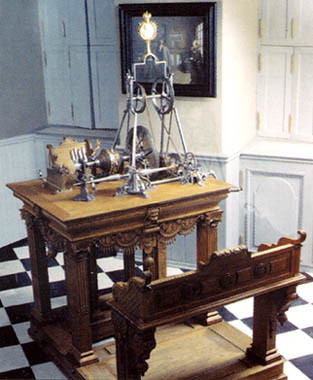
PREV ARTICLE
NEXT ARTICLE
FULL ISSUE
PREV FULL ISSUE
DID THE RUSSIANS INVENT THE DIE-ENGRAVING PANTOGRAPH?
Dick Johnson poses an interesting question: did the Russians invent the die-engraving pantograph machine?
-Editor
The metal parts of the reconstructed 1993 machine were so precise it worked as well as the original years before. The machine was called the "medallic lathe of Peter the Great," named after its royal patron, who had established a "turnery" where it was first used. This was a studio where artists created small bas-relief objects carved in bone and other materials on a variety of turning lathes. That original machine was described in detail by inventor Nartov in his 1755 manuscript, "Teatrum Machinrum," which could also be another name for the machine. The article also calls the reconstruction a "medallic-copier lathe." It has also been referred to in print as a "medallion engraver." With all these names one might expect this contrivance was the earliest "holy grail" sought by hand engravers for centuries -- a machine that eliminated the tedium of hand engraving. Not so. Today we can best describe Nartov's creation as an elaborate "cameo cutter." Cameos have been known since ancient times, originally carved by hand, much like dies were hand engraved. However dies were cut negative to strike positive images, cameos were carved positive, one at a time, without any means or necessity of replication. The first cameo cutting innovation was to power the drill bit with a bow. Imagine a Boy Scout using a bow to start a fire. The bow string wrapped around the drill rotated it as the bow was applied back and forth. What Nartov may have invented was the foot power applied to his elaborate lathe (like a foot-powered sewing machine of the 19th century). Amazingly the foot power mechanism is missing from both photo or drawing, but the attached article mentions a mysterious "foot gear." We observe the chuck where the discs to be carved were affixed and the spindle where the cutting point was placed. But we see no provisions for any pantographic reduction. In Peter's workshop "turnery" artists cut objects in bone, even from mammoth tusks, as they may have had on hand a considerable supply of these. A few were even cut in metal, as a portrait mold (obviously for casting) is shown in the article. There is no evidence, however, a die was cut in this workshop which could have been used for striking. (Such technology could have cut a die, however; it would be unusual for this to be overlooked.) But without this evidence we must class Nartov's machine as a cameo cutter. Thus it cannot be classed as a die-engraving machine. One of Nartov's machines was in a Paris museum. I had reference to this in my notes (where I learned of this in the Oxford publication A History of Technology by Singer and others, vol 4). In a study of the die-engraving pantograph, I noted Nartov's machine was a precursor, along with cameo cutters developed in other countries, notably Britain and France. The first truly engraving machine was the Belgium Hulot of 1766 (documented in Denis Cooper's Art & Craft of Coinmaking, illustrated page 166). This machine had peddle power and was followed by minor improvements by Frenchmen Mercklein (1767) and Dupeyrat (ca 1788). The second generation of engraving machines was powered by waterwheels and belting until Mathew Boulton and James Watt added steam power to their engraving machine at the Soho Mint in 1790. The fourth generation was dominated by Victor Janvier who started experimenting in 1892 with his improvements (twin cone drives of the cutting tool and the speed of the rotating pattern and diestock) and patented his miracle machine in 1899. I wrote more extensively on the die-engraving pantograph in The E-Sylum March 14, 2004. To answer the question posed in the headline: No. Nartov's machine was not a die engraver, but only a cameo cutter. The invention of the die-engraving pantograph clearly rests with Hulot of Belgium. I wish we knew his full name -- he deserves the credit! (Alphée Dubois did an 1875 portrait medal of "M. Hulot;" is this our inventor? Forrer's Biographical Dictionary, 1:631). But of all these engraving machines the best was Janvier's machine. Mints of the world beat a path to his Paris factory to obtain his die-engraving pantograph. To read the complete article (it's in English), see: Peter the Great's ornamental turning lather (www.mokeeva.com/e-machine.htm)
To read the earlier E-Sylum article, see:
THE JANVIER DIE-ENGRAVING PANTOGRAPH
(www.coinbooks.org/esylum_v07n11a10.html)
The Numismatic Bibliomania Society is a non-profit organization promoting numismatic literature. See our web site at coinbooks.org. To submit items for publication in The E-Sylum, write to the Editor at this address: whomren@gmail.com To subscribe go to: https://my.binhost.com/lists/listinfo/esylum All Rights Reserved. NBS Home Page Contact the NBS webmaster 
|
